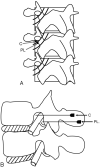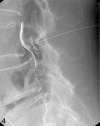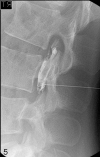Comparison of the temporary diagnostic relief of transforaminal epidural steroid injection approaches: conventional versus posterolateral technique
- PMID: 17296980
- PMCID: PMC7977402
Comparison of the temporary diagnostic relief of transforaminal epidural steroid injection approaches: conventional versus posterolateral technique
Abstract
Background and purpose: Conventional transforaminal epidural steroid injection (TFESI) has several problems. The purpose of this study was to compare the temporary diagnostic relief and advantages of TFESI performed using the conventional and posterolateral approaches.
Methods: From August to December 2004, 187 patients received TFESI for lumbar radicular pain. A total of 108 patients (65 women, 43 men; mean age, 56 years) fulfilled the inclusion criteria. In essence, the needle target point was the "safe triangle," but if there was a possibility that the needle could penetrate the nerve root or that the injectate could contact spinal nerve, posterolateral TFESI was used as an alternative. Image analyses of needle positions and chart reviews were performed. Logistic regression analysis and t test were used for statistical analysis.
Results: Of the 108 patients, 75 (69.4%) showed an improvement at 2 weeks after TFESI. In 46 patients (42.6%), the needle was located in the posterolateral epidural space, and 33 (71.7%) of those experienced pain relief. Of the 62 patients in whom the needle was located in the anterior epidural position, 42 (68%) experienced pain relief. There was a significant reduction in pain sense for the posterolateral approach (P < .05). However, no statistical difference was found between the 2 approaches and temporary diagnostic relief, and no correlation was found between the other variables tested and temporary diagnostic relief (P > .05).
Conclusion: Our findings suggest that the posterolateral approach is an alternative method for TFESI in cases where needle tip positioning in the anterior epidural space is difficult.
Figures





Similar articles
-
Contrast flow selectivity during transforaminal lumbosacral epidural steroid injections.Pain Physician. 2008 Nov-Dec;11(6):855-61. Pain Physician. 2008. PMID: 19057631
-
Outcome of Transforaminal Epidural Steroid Injection According to the Severity of Lumbar Foraminal Spinal Stenosis.Pain Physician. 2018 Jan;21(1):67-72. Pain Physician. 2018. PMID: 29357335
-
An alternative approach for lumbar transforaminal epidural steroid injection-Far lateral approach.Pain Pract. 2021 Nov;21(8):978-983. doi: 10.1111/papr.13060. Epub 2021 Aug 4. Pain Pract. 2021. PMID: 34275177
-
Transforaminal epidural steroid injection in the treatment of lumbosacral radicular pain caused by epidural lipomatosis: a case series and review.J Back Musculoskelet Rehabil. 2014;27(2):181-90. doi: 10.3233/BMR-130434. J Back Musculoskelet Rehabil. 2014. PMID: 24254495 Review.
-
The Lumbar Neural Foramen and Transforaminal Epidural Steroid Injections: An Anatomic Review With Key Safety Considerations in Planning the Percutaneous Approach.AJR Am J Roentgenol. 2017 Jul;209(1):W26-W35. doi: 10.2214/AJR.16.17471. Epub 2017 May 15. AJR Am J Roentgenol. 2017. PMID: 28504548 Review.
Cited by
-
A Proposed Personalized Spine Care Protocol (SpineScreen) to Treat Visualized Pain Generators: An Illustrative Study Comparing Clinical Outcomes and Postoperative Reoperations between Targeted Endoscopic Lumbar Decompression Surgery, Minimally Invasive TLIF and Open Laminectomy.J Pers Med. 2022 Jun 29;12(7):1065. doi: 10.3390/jpm12071065. J Pers Med. 2022. PMID: 35887562 Free PMC article.
-
A direct posterior approach for lumbar transforaminal epidural steroid injection.Interv Pain Med. 2022 Jul 8;1(3):100119. doi: 10.1016/j.inpm.2022.100119. eCollection 2022 Sep. Interv Pain Med. 2022. PMID: 39238515 Free PMC article. No abstract available.
-
Use of "Inside-Out" Technique for Direct Visualization of a Vacuum Vertically Unstable Intervertebral Disc During Routine Lumbar Endoscopic Transforaminal Decompression-A Correlative Study of Clinical Outcomes and the Prognostic Value of Lumbar Radiographs.Int J Spine Surg. 2019 Oct 31;13(5):399-414. doi: 10.14444/6055. eCollection 2019 Oct. Int J Spine Surg. 2019. PMID: 31741829 Free PMC article.
-
Feasibility of Deep Learning Algorithms for Reporting in Routine Spine Magnetic Resonance Imaging.Int J Spine Surg. 2020 Dec;14(s3):S86-S97. doi: 10.14444/7131. Int J Spine Surg. 2020. PMID: 33298549 Free PMC article.
-
Kambin's Triangle Approach of Lumbar Transforaminal Epidural Injection with Spinal Stenosis.Ann Rehabil Med. 2011 Dec;35(6):833-43. doi: 10.5535/arm.2011.35.6.833. Epub 2011 Dec 30. Ann Rehabil Med. 2011. PMID: 22506212 Free PMC article.
References
-
- Botwin KP, Gruber RD, Bouchlas CG, et al. Fluoroscopically guided lumbar transforaminal epidural steroid injections in degenerative lumbar stenosis. Am J Phys Med Rehabil 2002;81:898–905 - PubMed
-
- Slipman CW, Chow DW. Therapeutic spinal corticosteroid injections for the management of radiculopathies. Phys Med Rehabil Clin N Am 2002;13:697–711 - PubMed
-
- Vad VB, Bhat AL, Lutz GE, et al. Transforaminal epidural steroid injections in lumbosacral radiculopathy: a prospective randomized study. Spine 2002;27:11–15 - PubMed
-
- Husemeyer RP, White DC. Topography of the lumbar epidural space. A study in cadavers using injected polyester resin. Anaesthesia 1980;35:7–11 - PubMed
-
- Bogduk N, Aprill C, Derby R. Epidural spinal injections. In: White AH, Schollerman J, eds. Spinal Care: Diagnosis and Treatment. St Louis: Mosby,1995. :322–43
Publication types
MeSH terms
Substances
LinkOut - more resources
Full Text Sources
Other Literature Sources
